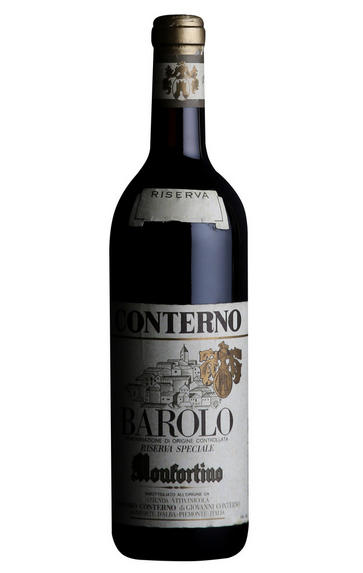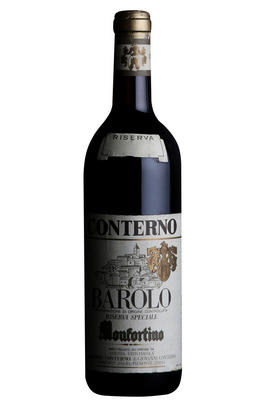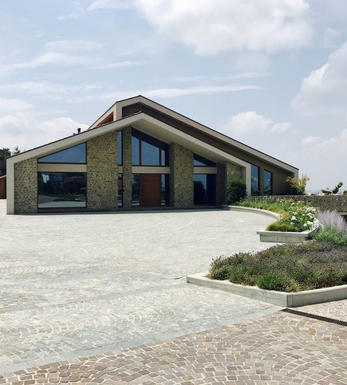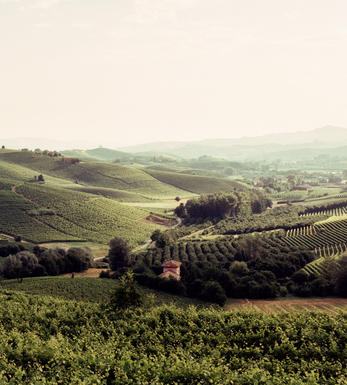
2002 Barolo, Monfortino, Riserva, Giacomo Conterno, Piedmont, Italy

Critics reviews
The 2002 Barolo Riserva Monfortino represents a significant turning point for Conterno. It was the first vintage in which the estate bottled Monfortino, but no Barolo Cascina Francia, a choice repeated in 2013 and 2014. It was a very cool and rainy year that I remember well, as I lived in Italy at the time. I also remember the sight of vineyards in La Morra totally decimated by hail in early September. Things were completely different over in Serralunga, however. Hail was not an issue, and the weather turned ideal in September and October, perfect for these late-ripening vineyards.
Giovanni and Roberto Conterno were annoyed that so many in the press had declared the vintage a disaster before the harvest was even finished. And so, they decided to surprise the world with this magnificent Barolo, which was held under wraps for several years. Today, at nearly eighteen years of age, the 2002 is an infant, but it is every bit as monumental as it has always been. Readers should expect a potent, tannic Monfortino for the ages.
Drink 2022 - 2042
Antonio Galloni, Vinous.com (February 2021)
A dark, imposing, but sensual wine, it flows from the glass with a breathtaking array of dried roses, autumn leaves, wild cherries, plums, new leather, espresso, licorice and spices, showing phenomenal depth, richness and balance. The tension between the luxuriousness of the fruit and the austerity of the vintage is truly captivating. I have tasted the 2002 Monfortino multiple times from barrel and bottle. At times it has reminded me of what I imagine the 1971 tasted like upon release, at other times it has seemed more similar to 1978. According to Giovanni Conterno, the 2002 reminded him of the 1971.
Either way, the wine is extraordinary. The 2002 Monfortino is the result of the cold vintage that was typical of Piedmont up until the mid 1980s. In many ways, it is a throwback to wines that cant be made anymore in Piedmont. Roberto Conterno thought so highly of the 2002 Monfortino he gave the wine an extra year in barrrel. And of course, there is one sad footnote.
The world lost Giovanni Conterno to cancer in 2004, but he made sure his last Monfortino was at least equal, if not better, than his most monumental wines. There is little doubt the 2002 Monfortino will soon take its place as one of the greatest Monfortinos ever made. It is the most fitting last chapter to the life of one of the worlds greatest winemakers.
As always, I suggest readers who have an interest in Monfortino taste the wine as soon as possible, as it will soon head into a period of dormancy, which in this vintage may last several decades. One of my favorite vintages for current drinking is the 1970, which still looks to have another 30 years of fine drinking ahead of it!
Drink 2027 - 2052
Antonio Galloni, Wine Advocate (December 2010)
13 September 2005 saw a huge hailstorm damage large parts of Barolo, but saved the north (Grinzane Cavour, Roddi) and parts of the south including Serralunga and Monforte d’Alba.
But although some very good wines were made, it was already condemned as a bad vintage, hence only Roberto Massolino (Vigna Rionda Riserva) and Giacomo Conterno (Monfortino) made Riservas. On the other hand, neither of the two made Riservas in 2003.
Mid mature-looking ruby. Sweet, opulently perfumed herbs and hints of dried fruit and dried orange. A little spiky and very lifted acidity. Lots of energy and quite bold tannin. Perhaps a little drying on the finish. Shows breeding, but less flattering than 2005. Very slow but long and complex finish. Freshness is key. Mid weight.
Drink 2014 - 2030
Walter Speller, JancisRobinson.com (February 2013)
About this WINE

Giacomo Conterno
Roberto Conterno took full control over the running of this famous estate just outside Monforte d'Alba, Piedmont, in 2003, when his father Giovanni Conterno passed away. Giovanni was the oldest son of the winery founder, Giacomo Conterno, and initially worked alongside his brother, Aldo Conterno. In 1969 the two sibling winemakers parted ways to create their own styles of Barolo.
Roberto continues to practice the traditional winemaking techniques of the area, producing long-lived, earthy wines. The focus has been strictly on nebbiolo and barbera since their freisa and dolcetto vines were grubbed up. Roberto also stresses the importance of organic viticulture especially in the early years of the vines' growth. The estate is most renowned for its great Barolos, Cascina Francia and Monfortino Riserva. The latter is produced only in the very best of vintages and aged at least 7 years in large oak 'botti'. This is regarded as one of the finest Barolos produced today and by many as the finest wine made from Nebbiolo in the world.
Roberto has recently introduced some small wooden 'fermentini' to further improve quality.

Barolo
Located due south of Alba and the River Tanaro, Barolo is Piedmont's most famous wine DOCG (Denominazione di Origine Controllata e Garantita), renowned for producing Italy's finest red wines from 100 percent Nebbiolo.
Its red wines were originally sweet, but in 1840 the then extant Italian monarchy, the House of Savoy, ordered them to be altered to a dry style. This project was realised by French oenologist Louis Oudart, whose experience with Pinot Noir had convinced him of Nebbiolo's potential. The Barolo appellation was formalised in 1966 at around 1,700 hectares – only a tenth of the size of Burgundy, but almost three times as big as neighbouring Barbaresco.
Upgraded to DOCG status in 1980, Barolo comprises two distinct soil types: the first is a Tortonian sandy marl that produces a more feminine style of wine and can be found in the villages of Barolo, La Morra, Cherasco, Verduno, Novello, Roddi and parts of Castiglione Falletto. The second is the older Helvetian sandstone clay that bestows the wines with a more muscular style. This can be found in Monforte d'Alba, Serralunga d'Alba, Diano d'Alba, Grinzane Cavour and the other parts of Castiglione Falletto. Made today from the Nebbiolo clones Lampia, Michet and Rosé, Barolo has an exceptional terroir with almost every village perched on its own hill. The climate is continental, with an extended summer and autumn enabling the fickle Nebbiolo to achieve perfect ripeness.
Inspired by the success of modernists such as Elio Altare, there has been pressure in recent years to reduce the ageing requirements for Barolo; this has mostly been driven by new producers to the region, often with no Piedmontese viticultural heritage and armed with their roto-fermenters and barriques, intent on making a fruitier, more modern style of wine.
This modern style arguably appeals more to the important American market and its scribes, but the traditionalists continue to argue in favour of making Barolo in the classic way. They make the wine in a mix of epoxy-lined cement or stainless-steel cuves, followed by extended ageing in 25-hectoliter Slavonian botte (barrels) to gently soften and integrate the tannins. However, even amongst the traditionalists there has been a move, since the mid-1990s, towards using physiologically (rather than polyphenolically) riper fruit, aided by global warming. Both modernist and traditional schools can produce exceptional or disappointing wines.
Recommended traditionalist producers:
Giacomo Borgogno, Giacomo Conterno, Bruno Giacosa, Elio Grasso, Marcarini, Bartolo Mascarello and Giuseppe Mascarello.
Recommended nmdernist producers:
Azelia, Aldo Conterno, Luciano Sandrone, Paolo Scavino and Roberto Voerzio

Nebbiolo
Nebbiolo is the grape behind the Barolo and Barbaresco wines and is hardly ever seen outside the confines of Piedmont. It takes its name from "nebbia" which is Italian for fog, a frequent phenomenon in the region.
A notoriously pernickety grape, it requires sheltered south-facing sites and performs best on the well-drained calcareous marls to the north and south of Alba in the DOCG zones of Barbaresco and Barolo.
Langhe Nebbiolo is effectively the ‘second wine’ of Piedmont’s great Barolo & Barbarescos. This DOC is the only way Langhe producers can declassify their Barolo or Barbaresco fruit or wines to make an early-drinking style. Unlike Nebbiolo d’Alba, Langhe Nebbiolo can be cut with 15% other red indigenous varieties, such as Barbera or Dolcetto.
Nebbiolo flowers early and ripens late, so a long hang time, producing high levels of sugar, acidity and tannins; the challenge being to harvest the fruit with these three elements ripe and in balance. The best Barolos and Barbarescos are perfumed with aromas of tar, rose, mint, chocolate, liquorice and truffles. They age brilliantly and the very best need ten years to show at their best.


Buying options
Add to wishlist
Description
The 2002 Barolo Riserva Monfortino represents a significant turning point for Conterno. It was the first vintage in which the estate bottled Monfortino, but no Barolo Cascina Francia, a choice repeated in 2013 and 2014. It was a very cool and rainy year that I remember well, as I lived in Italy at the time. I also remember the sight of vineyards in La Morra totally decimated by hail in early September. Things were completely different over in Serralunga, however. Hail was not an issue, and the weather turned ideal in September and October, perfect for these late-ripening vineyards.
Giovanni and Roberto Conterno were annoyed that so many in the press had declared the vintage a disaster before the harvest was even finished. And so, they decided to surprise the world with this magnificent Barolo, which was held under wraps for several years. Today, at nearly eighteen years of age, the 2002 is an infant, but it is every bit as monumental as it has always been. Readers should expect a potent, tannic Monfortino for the ages.
Drink 2022 - 2042
Antonio Galloni, Vinous.com (February 2021)
wine at a glance
Delivery and quality guarantee